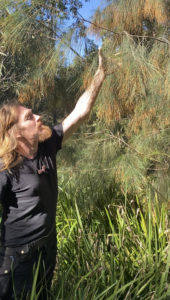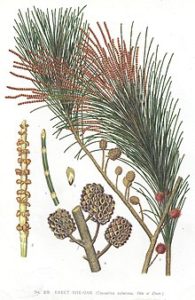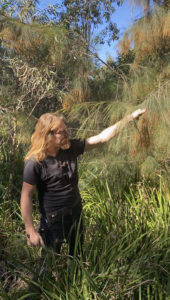There are many sub-species of sheoak that grow along coastal areas and sheoaks that can also survive in inland areas of Australia.
With around 50 different types of sheoak in Australia and so many uses for this versatile life-giving, healing and nourishing tree. This is a great plant to know and a personal favourite of mine.

Currently in New South Wales Sheoak are protected for reason of their root system’s support of river and coastal landscapes. The river sheoak’s root system can grow deep and intertwines in a thick mat to prevent soil and land erosion.
I like to use sheoak end branch tips in making smudge sticks as the cylindrical needles burn a wonderful scent and cleansing, healing and evoking smoke.
Fresh leaves can be chewed on to produce saliva in times of drought and the tiny bulb like buds that form in winter can also be chewed on for sustenance. The seeds are edible can be roasted and eaten. The sap is also a source of water in an emergency situation.
Where sheoaks are growing can also be an indicator of fresh groundwater tables when trying to locate drinking water. Where borers tunnel into the tree’s trunk there is an edible gum produced than can be collected that is highly energising to suck on. This gum could also be used for burning in ceremonies just like how frankincense is used.
The young green cones can be sucked or chewed to help with toothache as they have both ant-bacterial and anaesthetic properties. The wood pulp of the Sheoak tree was also mixed with water and swished around the mouth for toothache.
A tea made from the bark is still commonly used all around the world for toothache, sore throat, coughs, headaches, diarrhoea, beri-beri, infections, tropical ulcers, and bruising. The leaves, bark and stem are also regarded as a contraceptive.

Its wonderful dark hardwood timber was once used for making boomerangs, tool handles, shields, hurdles, shingles, clubs, mauls and bullock yokes.
To this day Sheoak remains a highly desirable timber for wood turning as it produces what is referred to as a birds-eye timber finish which is the unique design on the polished grain of the timber that looks similar to many little eyes.
The timber is also great for firewood burning as it is known to burn at a much higher temperatures than most other timbers, and sheoak branches will also burn green pulled straight from the tree.
Sheoak ash can be used used to make soap and ash produced from burning the leaves and mature brown cones was used for the extraction of salt. The ash can also be used as an ingredient in spice mixes, and sheoak sawdust is still used and sold for smoking purposes.
Most importantly our threatened Glossy black cockatoo and many parrots and native birds thrive off our remaining 143 million hectares of Sheoak forests here in Australia. Let us respect her and work with the spirit of the wonderful Sheoak tree.
